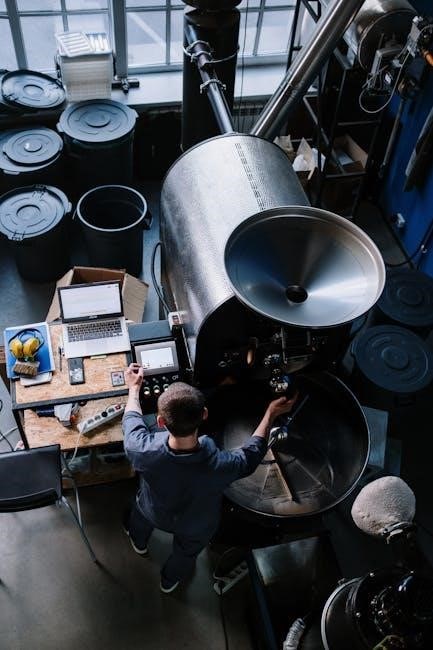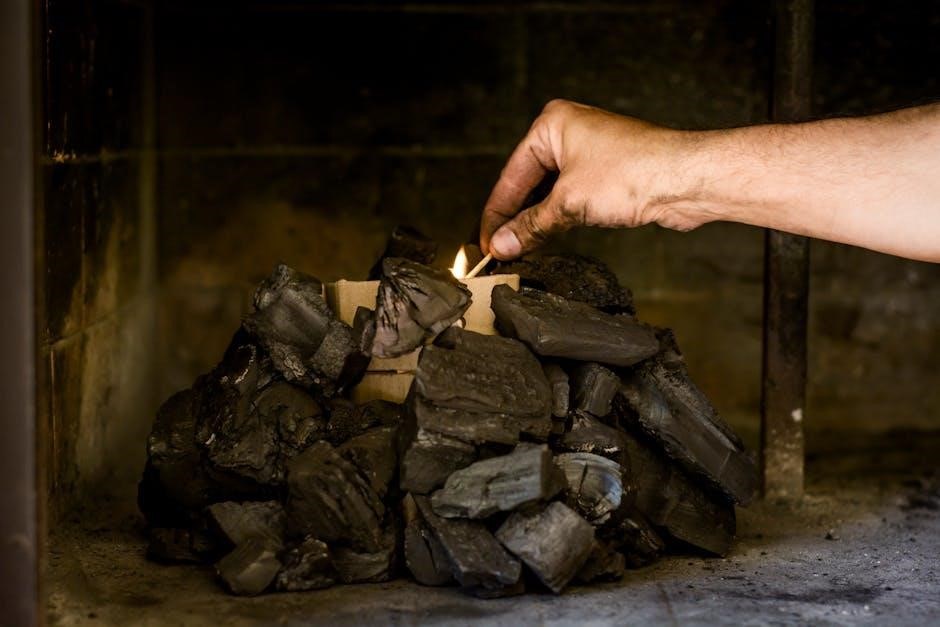A manual air fryer is a kitchen appliance that uses hot air circulation for cooking, offering a healthier alternative to deep-frying with minimal oil․ It features analog controls for temperature and timer, providing users with precise customization․ Known for its affordability, compact design, and ease of use, manual air fryers are ideal for outdoor activities like camping․ They require hands-on monitoring but deliver great results for those who enjoy cooking with control and versatility․
1․1 What is a Manual Air Fryer?
A manual air fryer is a kitchen appliance that cooks food using hot air circulation, enabling crispy results with minimal oil․ It uses analog controls for temperature and time, offering hands-on customization․ Unlike digital air fryers with preset settings, manual models provide simplicity and affordability․ Ideal for smaller families or outdoor use, they are compact and portable, making them perfect for camping․ This budget-friendly option appeals to those who prefer direct control over cooking settings, ensuring a healthier frying alternative without compromising on flavor or texture․
1․2 Key Features of Manual Air Fryers
Manual air fryers are characterized by their analog controls, offering straightforward temperature and timer adjustments․ They are cost-effective and compact, making them ideal for small spaces and outdoor use․ These appliances provide customizable cooking options, allowing users to tailor settings to specific recipes․ While they lack advanced digital features, their simplicity ensures ease of use for those who prefer a hands-on approach․ The absence of complex settings makes them lightweight and energy-efficient, perfect for beginners or those seeking a no-frills cooking experience․ Their portability and ease of operation make manual air fryers a practical choice for everyday meals and outdoor adventures․

Advantages of Manual Air Fryers
Manual air fryers are cost-effective, compact, and portable, making them ideal for outdoor use and small kitchens․ They offer customizable control over temperature and time, ensuring precise cooking results while being energy-efficient and easy to maintain․
2․1 Cost-Effectiveness
Manual air fryers are a budget-friendly option, offering significant savings compared to digital models․ Priced lower, they provide excellent value for those seeking a cost-effective way to enjoy healthier cooking․ With no advanced features, they focus on essential functions, making them a practical choice for small families or individuals․ Their affordability ensures you can invest in quality without overspending, proving that you don’t need to break the bank to adopt a healthier cooking method․ This makes manual air fryers an accessible and economical addition to any kitchen․

2․2 Compact and Portable Design
Manual air fryers are designed to be compact and lightweight, making them highly portable․ Their smaller size allows for easy storage in tight kitchen spaces and simplifies transport for outdoor activities like camping․ The lightweight construction ensures they can be carried without effort, while their compact footprint fits neatly on countertops․ This portability makes manual air fryers ideal for travel enthusiasts, campers, or those with limited kitchen space․ Their ease of handling and storage adds to their practicality, offering a convenient cooking solution wherever you go․
2․3 Easy to Use for Outdoor and Camping
Manual air fryers are perfect for outdoor adventures and camping due to their simplicity and portability․ With no complex digital settings, they are easy to operate in remote locations․ Their lightweight and compact design makes them easy to pack and transport, while analog controls require minimal setup․ Whether cooking on a camping trip or at an outdoor gathering, manual air fryers ensure crispy, delicious meals without the need for excessive oil․ Their straightforward functionality and durability make them an excellent choice for outdoor enthusiasts seeking a reliable cooking solution in the wilderness․
2․4 Customization and Control

Manual air fryers provide exceptional customization and control, allowing users to tailor their cooking experience․ With analog knobs, you can adjust temperature and timer settings precisely, ensuring your food is cooked to your exact preferences․ This hands-on approach enables you to fine-tune settings during cooking, achieving perfect results for various dishes․ While it requires more attention than digital models, manual control offers unparalleled versatility, making it ideal for those who enjoy experimenting with cooking techniques and exploring new recipes․ The ability to monitor and adjust settings manually ensures a personalized cooking experience every time․

How to Use a Manual Air Fryer
Using a manual air fryer involves preheating, adjusting temperature, setting the timer, and placing food in the basket․ Monitor cooking and shake food for even results, ensuring crispy textures with minimal effort and oil․
3․1 Preparing the Air Fryer
Before using your manual air fryer, thoroughly read the user manual to understand its components and controls․ Clean the appliance to remove any manufacturing residues, ensuring it’s ready for use; Familiarize yourself with the basket, temperature knob, and timer․ Preheating is essential; turn it on and set the desired temperature to allow the air fryer to reach the optimal heat level․ Always ensure the basket is properly placed and the air fryer is on a stable, heat-resistant surface․ Proper preparation ensures safe and effective cooking, helping you achieve the best results for your dishes․
3․2 Setting the Temperature
Setting the temperature on a manual air fryer involves using the analog control knob to adjust the heat level․ This feature allows you to customize the cooking process based on your recipe’s requirements․ For example, delicate foods like fish may require lower temperatures, while crispy dishes like fries need higher heat․ Rotate the knob to your desired temperature, ensuring it aligns with the markings on the appliance․ Always refer to your air fryer’s manual for specific temperature guidelines․ Proper temperature control ensures even cooking and helps achieve the desired texture and flavor for your dishes․
3․3 Adjusting the Timer
Adjusting the timer on a manual air fryer involves using the analog knob to set the cooking duration․ Simply rotate the knob to your desired time, ensuring it aligns with the marked minutes․ The timer allows you to precisely control how long your food cooks, preventing overcooking or undercooking․ For delicate items like vegetables, shorter times are ideal, while heartier foods like chicken may require longer durations․ Once set, the air fryer will automatically shut off when the timer expires, ensuring your meal is cooked to perfection․ Always monitor the cooking progress, especially near the end, to achieve the best results․
3․4 Preheating the Air Fryer
Preheating a manual air fryer is a crucial step to ensure even cooking and achieve the best results․ To preheat, turn on the appliance and set the temperature using the manual knob to your desired level․ Allow the air fryer to warm up for 2-5 minutes, depending on the model and the temperature selected․ This step ensures the unit reaches the optimal heat before adding food, preventing hot spots and undercooked areas․ Always refer to your air fryer’s manual for specific preheating recommendations, as times may vary; Proper preheating helps in achieving a crispy texture and enhances the overall cooking performance․
3․5 Placing Food in the Basket
When placing food in the basket of your manual air fryer, ensure it is spread evenly in a single layer to allow proper air circulation․ Overcrowding can lead to uneven cooking, so avoid filling the basket to its maximum capacity․ Pat dry moist foods like vegetables or meats with a paper towel before adding them to the basket to enhance crispiness․ Lightly coat food with oil or non-stick spray for better browning and to prevent sticking․ Adjust the basket position as needed during cooking to ensure all food cooks uniformly․ For best results, cook in portions if necessary, to maintain optimal air flow․
3․6 Monitoring and Adjusting During Cooking
Monitoring your manual air fryer during cooking is essential for achieving perfect results․ Regularly check the food through the window to ensure it cooks evenly․ Adjust the temperature and timer knobs as needed to prevent overcooking or undercooking․ Shake the basket halfway through cooking to redistribute food, promoting uniform crispiness․ Use a spatula to gently turn or flip larger items like chicken or steak for consistent results․ Keep the air fryer on a stable, heat-resistant surface and avoid overcrowding the basket․ Proper monitoring ensures your dishes turn out crispy, golden, and flavorful, making the manual process worthwhile for precise control․
3․7 Turning Off and Handling the Basket

After cooking, turn off the air fryer using the power button and unplug it to conserve energy․ Handle the basket with care, as it may be hot․ Use oven mitts or tongs to remove the basket and place it on a heat-resistant surface․ Allow it to cool slightly before washing with warm, soapy water․ Avoid using abrasive cleaners to maintain the non-stick coating․ Dry thoroughly before storing․ Always let the air fryer cool down completely before cleaning to prevent burns․ Proper handling ensures longevity and safety, keeping your manual air fryer in great condition for future use․

Cooking Techniques with a Manual Air Fryer
Cooking with a manual air fryer involves techniques like even food placement, shaking, and using oil or non-stick spray for crispiness․ Monitoring and adjusting settings ensures perfect results․
4․1 Even Food Placement
Even food placement is crucial for optimal cooking results․ Arrange ingredients in a single layer, avoiding overcrowding, to ensure consistent air circulation․ This prevents uneven cooking and promotes crispiness․ For best results, pat dry foods like fries or chicken wings before placing them in the basket․ Lightly brush with oil or non-stick spray to enhance browning․ Proper spacing allows hot air to circulate freely, cooking each piece evenly․ This technique is especially important in manual air fryers, as it relies on precise control over food arrangement to achieve desired textures and flavors․ Even placement ensures every bite is perfectly cooked and delicious․
4․2 Shaking or Turning Food
Shaking or turning food during cooking ensures even crispiness and prevents hot spots․ For foods like fries or chicken wings, gently shake the basket halfway through cooking․ Use tongs or a spatula to flip larger items like steak or fish, ensuring both sides cook evenly․ Avoid overcrowding to make turning easier․ This step is crucial in manual air fryers, as it relies on manual intervention for consistent results․ Regular turning promotes uniform browning and prevents food from sticking․ Always handle the basket carefully, as it may be hot, and consider wearing oven mitts for safety․ This technique enhances the overall quality of your dishes․
4;3 Using Oil or Non-Stick Spray
Using a light coating of oil or non-stick spray enhances browning and prevents food from sticking to the basket․ While manual air fryers require minimal oil, a small amount ensures crispiness and flavor․ For non-stick baskets, a spray or brush of oil suffices, but for denser foods like vegetables or breaded items, a light drizzle works best․ Avoid overusing oil to maintain the health benefits of air frying․ This step is optional but recommended for achieving optimal results and making cleanup easier․ Always choose oil with a high smoke point for best performance․
4․4 Achieving Crispy Texture
Achieving a crispy texture in a manual air fryer requires careful preparation and technique․ Pat food dry before cooking to remove excess moisture, ensuring better browning․ Lightly spray or brush food with oil to enhance crispiness․ Preheating the air fryer is crucial, as it ensures even heat distribution․ For foods like fries or chicken, shake the basket halfway through cooking to promote even crispiness․ Avoid overcrowding, as this hinders air circulation․ Adjusting the temperature and cooking time manually allows for precise control, helping you achieve the perfect golden-brown finish․ These steps ensure your dishes are crispy and flavorful, just like deep-fried options but with much less oil․

Manual Air Fryer vs․ Digital Air Fryer
A manual air fryer offers cost-effectiveness and manual control, ideal for those who prefer simplicity and outdoor use, while a digital air fryer provides advanced features and preset settings for convenience․
5․1 Key Differences
The primary distinction lies in their control systems: manual air fryers use analog knobs for temperature and time, offering hands-on control, while digital air fryers rely on digital interfaces and preset settings․ Manual models are generally more affordable and compact, making them ideal for outdoor use, whereas digital versions often come with advanced features like touchscreens and smartphone apps․ Manual air fryers require active monitoring, whereas digital models automate cooking processes for convenience․ Design-wise, manual air fryers are simpler and more portable, while digital ones may include additional cooking modes and precision controls, catering to different user preferences and cooking styles․
5․2 Customization vs․ Convenience
Manual air fryers prioritize customization, allowing users to adjust temperature and time settings freely, which is ideal for those who enjoy precise control over their cooking․ This hands-on approach enables creativity and flexibility, making it suitable for experienced cooks or those who prefer tailored results․ On the other hand, digital air fryers emphasize convenience, offering preset settings and automated cooking processes that simplify meal preparation; While they may lack the same level of manual control, digital models are perfect for busy individuals seeking quick and consistent outcomes with minimal effort․ The choice depends on whether customization or ease of use is more important to the user․
5․3 Precision vs․ Efficiency
Manual air fryers excel in precision, allowing users to fine-tune temperature and time settings for specific cooking needs, which is ideal for achieving perfect results․ However, this level of control requires active monitoring and adjustments, making the process less efficient․ In contrast, digital air fryers prioritize efficiency with preset settings and automated cooking, reducing the need for constant supervision․ While they may lack the same precision, digital models are faster and more convenient for users seeking quick, consistent outcomes․ The trade-off lies in whether precise control or speed is more important for the cooking experience․
5․4 Versatility vs․ Ease of Use
Manual air fryers offer great versatility, allowing users to experiment with various cooking techniques and recipes by adjusting temperature and time settings․ This flexibility appeals to adventurous cooks who enjoy customization․ However, they require more hands-on involvement and a learning curve to master․ In contrast, digital air fryers prioritize ease of use with preset settings and automated functions, making them ideal for those who value simplicity and quick results․ While they may lack the same level of customization, digital models are more user-friendly and convenient for everyday cooking․ The choice depends on whether versatility or ease of use is more important to the user․

Tips for Getting the Most Out of Your Manual Air Fryer
Experiment with recipes, avoid overcrowding the basket, and clean regularly for optimal performance․ Proper preheating and food arrangement ensure even cooking and crispy results every time․
6․1 Experimenting with Recipes
Experimenting with recipes is key to maximizing your manual air fryer’s potential․ Try various seasonings, marinades, and cooking techniques to discover new flavors․ From crispy snacks to hearty main dishes, the versatility of manual air fryers allows for endless creativity․ Explore different cuisines, like Asian-style stir-fries or Mediterranean-inspired dishes, to add variety to your meals․ Don’t hesitate to adapt oven or pan recipes for air frying—simply adjust cooking times and temperatures․ Keeping a cooking journal can help track your successes and refine future experiments․ This hands-on approach fosters culinary innovation and ensures you get the most out of your appliance․
6․2 Avoiding Overcrowding
Avoiding overcrowding is crucial for optimal results when using a manual air fryer․ Overcrowding prevents proper air circulation, leading to uneven cooking and less crispy textures․ To ensure even cooking, cook food in batches if necessary, and arrange items in a single layer within the basket․ This allows hot air to circulate freely around each piece, promoting uniform browning and crispiness․ For best results, avoid piling food excessively, as this can hinder the air fryer’s performance․ By giving your ingredients enough space, you’ll achieve perfectly cooked dishes every time․ This simple practice enhances both flavor and texture․ Always prioritize a balanced load for ideal outcomes․
6․3 Cleaning and Maintenance
Regular cleaning and maintenance are essential to ensure your manual air fryer performs optimally․ After each use, wash the basket and pan with warm soapy water, avoiding abrasive cleaners or metal scourers that could damage the non-stick coating․ Dry thoroughly before storing to prevent rust․ For tough food residue, soak the parts in soapy water for 30 minutes․ Always clean the exterior with a damp cloth to remove splatters; Proper maintenance prevents bacterial growth and ensures longevity․ Neglecting cleaning can lead to poor performance and unpleasant odors․ Keep your air fryer in top condition for consistent cooking results and hygiene․

Safety Precautions
Always handle hot surfaces with care, use oven mitts, and keep children away․ Avoid water contact with electrical parts and ensure food isn’t overheated to prevent fires․
7․1 Handling Hot Surfaces
Handling hot surfaces of a manual air fryer requires caution to avoid burns․ Always use oven mitts or tongs when removing the basket or touching exterior surfaces․ Never place the air fryer near flammable materials or leave it unattended while in use․ Ensure the air fryer is on a stable, heat-resistant surface․ Allow it to cool down completely before cleaning or storing․ Keep children away from the appliance during operation․ Proper handling ensures safer cooking and prevents accidents․
7;2 Electrical Safety
Ensuring electrical safety when using a manual air fryer is crucial to prevent hazards․ Always place the air fryer on a stable, heat-resistant surface away from water to avoid electrical shock․ Keep children away from the appliance and its cord․ Never overload circuits or use damaged power cords․ Avoid touching electrical components with wet hands․ Regularly inspect the air fryer for signs of wear or damage, such as frayed cords or malfunctioning buttons․ If damage is detected, stop use immediately․ Adhere to the manufacturer’s guidelines for voltage and power requirements to ensure safe operation․
7․4 Food Safety Guidelines
To ensure food safety while using a manual air fryer, always handle ingredients hygienically and cook them to the recommended internal temperature․ Prevent overcrowding in the basket to allow even air circulation, which helps avoid undercooked areas․ Use oil or non-stick sprays to prevent food from sticking and promote even cooking․ Preheat the air fryer before adding food to eliminate bacteria․ After cooking, clean the basket and pan thoroughly with warm, soapy water to maintain hygiene․ Regularly sanitize all parts to prevent foodborne illnesses․ Proper food safety practices ensure delicious and healthy meals every time․
Manual air fryers offer a cost-effective, portable, and customizable cooking solution․ Their simplicity and control make them ideal for home and outdoor use, encouraging culinary creativity․
8․1 Final Thoughts on Manual Air Fryers
Manual air fryers are a practical and cost-effective choice for those seeking a healthier cooking method․ Their simplicity and portability make them ideal for small kitchens, camping, or outdoor use․ While they require more hands-on control compared to digital models, this feature appeals to users who value customization and precision․ For budget-conscious individuals or those who prefer a straightforward cooking experience, manual air fryers offer great value and versatility․ They are a worthwhile investment for anyone looking to explore the world of air frying without breaking the bank․
8․2 Encouragement to Try Manual Mode
Experimenting with manual mode on your air fryer can elevate your cooking experience by offering unparalleled control and customization․ While it may require more attention, the ability to fine-tune temperature and time ensures perfectly cooked dishes tailored to your preferences․ For those who enjoy hands-on cooking, manual mode fosters creativity and skill development․ It’s a great way to explore new recipes and techniques, delivering crispy, flavorful results․ Whether you’re a budget-conscious buyer or a culinary enthusiast, manual air fryers provide a cost-effective and versatile tool that’s worth trying for a more personalized and satisfying cooking journey․
